
In response to the pressing challenges posed by climate change and the need for a meaningful action plan for climate protection, the ECB, together with other European and international institutions as well as national central banks (NCBs), continues its efforts to tackle one of the most significant challenges of our times. Our contribution is not only limited to the policy arena, but is also coupled with credible efforts ‘at home’ through improved environmental performance in our own operations.
This year is the ninth consecutive year of the ECB’s registration with the European Eco-Management and Audit Scheme (EMAS), and I am proud to be part of an institution that takes on its responsibility to protect the environment and sets strategic objectives and measures to support the achievement of EU targets. We will look for further opportunities to complement our environmental programme with a more comprehensive approach that integrates all dimensions of sustainability and brings forward our contribution to fulfilling the Sustainable Development Goals.
This environmental statement is a summary of our focused efforts over the previous year and offers a glimpse into the innovative work of numerous dedicated teams and individuals across the ECB who strive to bring positive change for the future.
During the past year, we have continued our efforts on raising and maintaining awareness and engagement of enhanced environmental protection among our staff and, equally, among our suppliers. Positive changes for the environment would not be possible without the continuous and collaborative efforts both within and outside of our organisation. I would like to express my gratitude towards those who have acted as catalysts for change to benefit the planet and the younger generations, not just by actively pursuing discussions and setting forth new proposals to improve the environmental performance of the ECB, but also by taking it onto themselves to lead change within the organisation and be role models within their spheres of influence.
The ECB’s commitment to tackle the challenges posed by climate change becomes stronger every year. We will continue to pursue our interinstitutional partnerships to share best practices and to set ambitious objectives for the years ahead to further embed sustainability in the work we do. Only in this way can we set a good example and steer the necessary change towards sustainable development.
Michael Diemer
Chief Services Officer
1 The ECB at a glance
The European Central Bank and the NCBs constitute the Eurosystem, the central banking system of the euro area. The main objective of the Eurosystem is to maintain price stability: safeguarding the value of the euro.
The European Central Bank is responsible for the prudential supervision of credit institutions located in the euro area and participating non-euro area Member States, within the Single Supervisory Mechanism, which also comprises the national competent authorities (NCAs). It thereby contributes to the safety and soundness of the banking system and the stability of the financial system within the EU and each participating member state.
More information about the ECB, the European System of Central Banks (ESCB) and the Eurosystem.

Credentials: European Central Bank and European Commission
1.1 Relevant changes for the environmental management system (EMS)

This environmental statement includes data relating to the buildings occupied by the ECB in 2018: the main building, the Eurotower and the Japan Center. From 2018 onwards, the ECB occupies the whole of the Japan Center, which has led to an overall increase in workplaces by approximately 7.4% overall. Thus, unlike in previous years, this year the ECB occupied the entire office space in all three buildings for the entire duration of the calendar year.
Unless specifically reported, as in previous years the environmental data for the buildings located in the city centre (the Eurotower and the Japan Center) have been aggregated, while the data for the main building are presented separately.
When comparing the data with that of previous years, it is important to note that a series of moves took place during the previous reporting cycle. In 2016, for instance, the Japan Center and the Eurotower were all occupied for part of the year only. In addition, having been built at various times over the last three decades, the ECB’s premises all differ in terms of their age and construction standards, thus making it challenging to draw exact comparisons and evaluate the development of certain environmental aspects.
In recognition of these complexities, it was thus decided to use 2018 as the new baseline year rather than 2015. While this re-baselining affects long-term objectives regarding energy efficiency and emissions, which had the reference year of 2015, the choice of 2018 as the new baseline year is more representative of both the current and the future organisational context, thereby strengthening the ECB’s commitment to reducing its environmental impact.
1.2 ECB premises
This section provides an overview of the three main sites where the ECB operates[1].
1.2.1 Main building

The ECB’s main building is located in the Ostend area of Frankfurt am Main. The main building is owned by the ECB and it houses just over half of the ECB’s workplaces. It was officially inaugurated in November 2014.
The building’s design and associated sustainability features ensure that it exceeds the requirements of the 2007 Energieeinsparverordnung (German federal energy-saving directive) by 29%. The main building includes the following key features:
- an energy-efficient triple-layered facade for the new high-rise tower, as well as energy-efficient insulation for the facades and roof of the Grossmarkthalle;
- natural ventilation based on operable facade elements, electric sun-shading and low-energy lighting, which provide optimal workplace conditions with maximum daylight;
- rainwater harvesting for irrigating the parkland area and also for sanitary use;
- use of recycled heat from the IT centre and the main atria;
- use of geothermal energy for heating and cooling the building.
The grounds of the main building were also landscaped, creating not only a positive working environment for staff but also providing a link with nearby parks and the city green belt, contributing to the creation of a “green lung” for the city of Frankfurt.
Read more about the ECB’s main building and sustainability features.
1.2.2 City centre (Eurotower and Japan Center)

Just under half of ECB workplaces are located in the Eurotower and the Japan Center, two rented premises in the city centre of Frankfurt am Main.
The ECB has rented space in the Japan Center since 2014, which hosts European banking supervision-related activities on an interim basis.
The Eurotower was refurbished between January 2015 and February 2016, and ECB employees working for ECB Banking Supervision moved into the building in March 2016. Environmental considerations played an important role during the refurbishment, and a variety of improvements to the Eurotower’s technical infrastructure were made. These included:
- installing energy-efficient sun-shading systems;
- insulating the concrete core;
- installing new combined heat and power plants;
- updating the air conditioning systems to improve energy efficiency;
- increasing the energy efficiency of the lifts;
- integrating an LED lighting system into the offices.
The implementation of these measures relates directly to the objective of improving the building’s efficiency, thereby reducing resource consumption and lowering the ECB’s carbon emissions. As a result of the gains in efficiency, the landlord intends to apply for an environmental certification for the building.
After ECB Banking Supervision staff moved into the Eurotower, the Japan Center also underwent refitting at the end of 2016 to allow the relocation of staff previously based in the former Commerzbank building. Following the relocation, the former Commerzbank building was handed back to its landlord and thus removed from the scope of the ECB’s EMS.
2 Environmental management at the ECB
2.1 Environmental policy

In terms of its environmental performance and objectives, the ECB’s overall intentions and direction are outlined in its environmental policy. The policy objectives are defined in a way that any resulting actions should have a direct and positive impact on the ECB’s overall environmental performance. Adopted in 2013, the latest version of the policy focuses on raising staff awareness and implementing behavioural changes through targeted actions.
Everyone who works in the ECB’s premises is invited to integrate the environmental policy into their daily tasks and to contribute actively to the achievement of its objectives. This can be done through adopting and implementing actions that can have a positive impact – be it directly or indirectly – on the ECB’s overall environmental performance.

2.2 Environmental management organisation

The Green ECB team monitors all EMS-relevant aspects and also coordinates related activities – supported by different stakeholders – across all ECB business areas. The team consists of an Environmental Coordinator and an Environmental Officer, both appointed by the Executive Board, as well as the Environmental Representatives and Deputies group, appointed by the senior management of their respective business areas. Environmental Experts support the Environmental Officer and the Environmental Representatives in fulfilling their mandates.
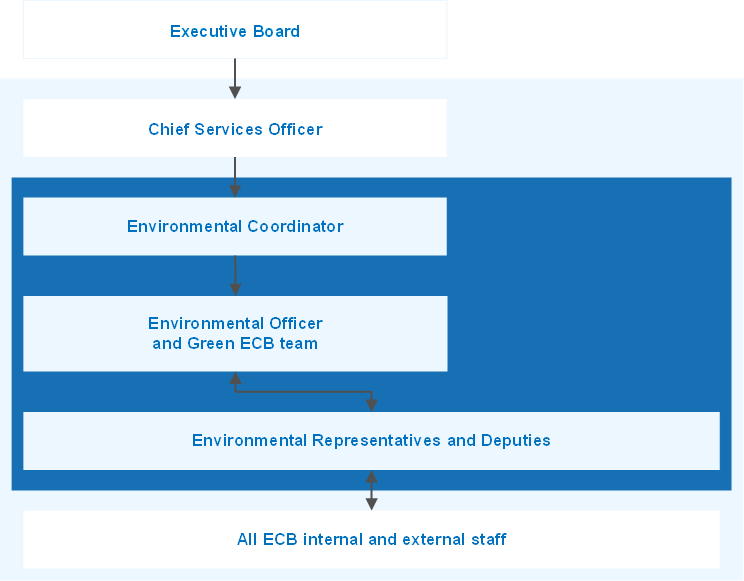
The roles and responsibilities of the Green ECB team are listed in the table below.

The ECB was included in the Eco-Management and Audit Scheme (EMAS) registry for the first time[2] in 2010, and the EMS also received EN ISO 14001 certification in the same year.
The EMS is integrated into the ECB’s general governance framework, as detailed in the Environmental Management Handbook (EMH). The EMH contains binding rules and processes, as well as operational procedures which aim to maintain the EMS according to standards and ensuring its adequate implementation in relevant areas. In addition, the document incorporates specific aspects that have a major impact on the environment (e.g. installations and facilities, IT infrastructure and equipment, travel, etc.) and provides guidance on how to integrate environmental requirements in order to reduce overall environmental impact.
In accordance with these standards, the EMS is subject to both internal and external environmental verification checks. The ECB has created specific instruments aimed at monitoring and measuring environmental performance to avoid divergences from the environmental governance framework. On an annual basis, the Environmental Officer carries out internal environmental verification checks with the support of external experts. By defining and implementing procedures and processes within the EMS, the ECB ensures compliance with environmental certification requirements.
The scope of the EMS includes all activities at the main building, the Japan Center and the Eurotower.
2.3 Compliance obligations

The EMAS regulations, together with the relevant German environmental legislation, and the environmental regulations of the city of Frankfurt, collectively define the requirements to be met by the ECB and its EMS. Therefore, for its premises in Frankfurt am Main, the ECB keeps a legal register containing all relevant legal obligations that have been identified and that have to be met. To ensure compliance, the legal register is reviewed and updated on a regular basis by dedicated legal experts. Relevant changes to the legal framework are directed to the respective business areas, which aim to define the necessary actions needed to maintain compliance. The majority of ECB’s environmental legal obligations relate to the operation of its buildings, their maintenance, in addition to services such as catering and cleaning. Legal compliance is checked in the context of annual internal environmental verifications; to date, no deviations from the legal requirements have been identified during these internal verification checks.
Table 1
Relevant areas of environmental legislation and related facilities/activities

In addition, the ECB has considered further environment-related obligations that go beyond the legal framework and to which the ECB has committed on a voluntary basis. In this regard, the development of sustainable procurement guidelines, environmental business objectives and raising awareness on environmental topics are some of the aspects considered. Moreover, the ECB recognises the challenges posed by climate change and, within its mandate, commits to contributing towards addressing them; for example, via supporting market participants, legislators and standard-setters as they work towards identifying climate change-related risks.
Read more about climate change and the ECB.
Beyond its organisational boundaries, the ECB actively engages with environmental management topics by participating in inter-institutional collaboration groups and networks such as the Groupe Interinstitutionnel de Management Environnemental (GIME) and the Environmental Network of Central Banks (ENCB).
2.4 Context of the organisation

To understand the organisational context in relation to the ECB’s EMS, as well as the needs and expectations of stakeholders, the Green ECB team and relevant counterparts examined and identified specific internal and external issues. This assessment aimed to identify aspects influencing the ECB’s environmental performance and which would need to be considered within the EMS. The ECB reviews its environmental context and stakeholders regularly, as well as examining risks and opportunities. This review is part of implementing and maintaining the EMS, and of establishing the ECB’s environmental objectives and measures. In 2018, as Benoît Coeuré and Sabine Lautenschläger, Members of the Executive Board of the ECB, have stated, climate change and its related impacts have been frequently highlighted as a risk driver for monetary policy[3]. Consequently, the ECB’s attention to climate risks has increased, as shown through its participation in the Network for Greening the Financial System (NGFS).
2.5 Environmental communication, engagement and awareness-raising activities




Completed = measure completed; in progress = measure in progress; proposal/new = new measure to be implemented in the next programme
2018 was another active and successful year for the ECB’s environmental communication and awareness-raising activities. The ECB engages with many different stakeholders on environmental topics through internal and external events, inter-institutional collaboration networks, training courses and information sessions. These stakeholders include staff, contractors, other European institutions and bodies, ESCB NCBs and other interested external parties.

Throughout the year, the Green ECB team has developed and participated in different activities which aim to contribute to reducing the ECB’s environmental impact by raising awareness and encouraging stakeholders to take an active role. For instance, the Green ECB team took part in town hall and business area meetings to inform and engage staff regarding the proposed activities, tools and services which can benefit the ECB from an environmental perspective.
In January 2018, the Green ECB team gave a presentation during a town hall meeting dedicated to the services areas, where they invited participants to take part in an imaginary journey of possibilities that promote sustainable and green outcomes at the ECB, while still working towards the strategic organisational goal of strengthening the ECB’s reputation as a world-class institution. Three practical examples were shown to staff, demonstrating different ways and areas in which teams can lead by example and contribute to making the ECB a more environmentally sound institution.
The three topics focused on during the event were:

There was also the opportunity for participants to contribute in real time via an app, thereby proposing new ideas and making commitments for the future.
In March 2018, the ECB joined the WWF Earth Hour for the seventh consecutive year. Together with millions of people and numerous organisations around the world, including 182 companies and other EU institutions in Frankfurt am Main, the ECB symbolically switched off all non-essential lights in its premises to demonstrate its commitment to raising awareness about the impact of climate change and the need to take meaningful action.

In summer 2018, the Green ECB team invited the Frankfurt chapter of the German non-profit environmental organisation Naturschutzjugend (NAJU) to run activities to raise awareness of the importance of biodiversity.
In September 2018, the ECB participated in European Mobility Week for the sixth consecutive year. During the course of the week, the Green ECB team organised car-free days as well as other activities to increase awareness about environmentally-friendly modes of transport. The theme of the 2018 European Mobility Week was “Mix and Move”, highlighting the concept and benefits of multimodality and sustainable transport methods. The ECB promoted clean mobility options in the Frankfurt region and informed staff about the CO2 emissions caused by different forms of transport. An information stand was also set up, providing additional information about available mobility options for commuters as well as for business travel. Bicycle safety inspections and numerous other engagement activities were additional highlights of the event.

Source: ECB.
In addition to the Green ECB team, EMS-related activities within the ECB are also supported by Environmental Representatives. Nominated by each business area, the Environmental Representatives support internal communication on environmental topics as well as green initiatives within the ECB, thereby increasing environmental awareness and strengthening the impact of internal activities. Indeed, the Environmental Representatives have been involved with local projects such as environment-related photography competitions as well as giving presentations on relevant topics to their colleagues. In addition to being easily accessible, by promoting the Green ECB team’s activities, they can also encourage other staff members to suggest environment-related improvements, as well as providing guidance on environmental information.


One of the ECB’s activities is developing and exchanging expertise on best practice on environmental management. Interinstitutional collaboration with other European institutions on this topic takes place through the ENCB and also via the GIME. The GIME, composed of a growing number of European institutions and bodies, aims at encouraging and facilitating the exchange of information and best practice on environmental issues; in particular, promoting the benefits and outcomes of EMAS.
Read more about EMAS in the European Institutions.
The ENCB is currently composed of 13 ESCB NCBs, and aims to build constructive cooperation to share experiences and best practices on environmental management, as well as implementing joint actions such as participating in the WWF Earth Hour.
3 The year in figures
Figure 1
2018 highlights

Source: ECB.
Figure 2
2018 in figures (and % change from 2017 to 2018)

Source: ECB.

The figures above provide a summary of the ECB’s environmental performance in 2018. The reported percentages, unless otherwise specified, refer to the difference between 2017 and 2018 data. The total number of workplaces[4] increased from 4,981 in 2017 to 5,348 in 2018. This increase must be considered when comparing the ECB’s environmental performance in 2018 with the previous year.
The consumption of electrical energy (100% renewable) increased, while the energy used for heating and cooling remained stable in all ECB premises. Geothermal energy generation has been activated at the main building, increasing the proportion of the ECB’s total energy consumption accounted for by renewable energy to 57%. Overall, total energy consumption increased slightly in 2018. However, consumption per workplace decreased for various environmental aspects, such as total energy consumption (-3.4%), energy consumption related to total heating and cooling (-9.2%) and total waste generation (-2.5%). Each of these developments is explained in more detail in Section 4.
Chart 1
Workplace overview
(number of workplaces)

Source: ECB.
4 Environmental aspects and impact of the ECB’s activities

The ECB monitors the environmental aspects of its activities and evaluates their development over time. Quarterly reporting on relevant data from the city centre premises and close exchanges with business areas take place to ensure legal compliance, avoid environmental risks and reduce the ECB’s environmental impact. City centre premises data include aspects directly related to the functioning of the ECB premises and aspects related to employee activity, such as energy consumption, emissions, waste production and water consumption. The latter group includes those aspects that can be considered a consequence of or indirectly connected to ECB activities, such as the environmental performance of service providers and purchased goods, business travel, staff commuting and their respective CO2 emissions.
The underlying data used to evaluate the impact of the ECB’s activities are collected in an environmental inventory that is updated on a yearly basis. Assessing the environmental data and how they change over time is key to identifying relevant measures for developing the environmental programme. The Green ECB team, together with the teams which coordinate the activities that have environmental aspects, examine ways to influence these aspects and establish new objectives and improvement measures.
The ECB’s environmental aspects were first identified in 2007. They are reviewed annually to consider any potential changes within the bank or to its context and activities. The aspects of the ECB’s activities that are identified as having a significant direct or indirect environmental impact are continuously reassessed so they reflect the increase in staff numbers and the new requirements of the standards. On the basis of the latest assessment and developments in recent years, we decided to stop estimating and reporting the emissions resulting from external visitors attending high-level conferences, events or seminars at the ECB, because sample checks revealed a high probability of double-counting the respective emissions as business travel by the delegates, because calculating the emissions requires a substantial amount of estimation, and because it is difficult to influence whether and how delegates choose to travel to the ECB. However, we will continue to pursue measures aimed at reducing the environmental impacts associated with this aspect.
Assessment of the environmental aspects
From this year onwards the different environmental aspects will be reported in an illustration, as shown below, instead of using a table as in previous years. As a result of the regular assessment, the direct and indirect environmental aspects are grouped in different categories on the basis of the possibility to influence them (x-axis) and their significance for the ECB’s environmental performance (y-axis).
Figure 3
Assessment of ECB’s direct environmental aspects

Source: ECB.
Figure 4
Assessment of ECB’s indirect environmental aspects

Source: ECB.
Notes: *The previous label was “Environmental performance of cleaning companies” and has been changed to improve clarity.
**The previous label was “Environmental performance of procured goods and services” and has been changed to improve clarity.
4.1 Energy efficiency


Notes: * The measures below have been adjusted to exclude efficiency measures for the city centre premises as current resource planning does not foresee budget allocation in this direction. Given that the main building is a new building, expected additional efficiency gains here are unlikely to be sufficient to cover for the city centre premises. Energy consumption in the city centre premises also influences the ECB’s overall CO2 emissions (e.g. through natural gas consumption) and the corresponding objective.


Completed = measure completed; in progress = measure in progress; proposal/new = new measure to be implemented in the next programme.

Despite the higher number of workplaces, total electricity consumption at the main building has steadily decreased since 2015, stabilising in 2018. This trend was related to the improvement in energy monitoring, which gave us a broader knowledge of energy flows, revealed further areas where energy efficiency could be improved and enabled new improvement measures to be established. As a consequence, measures were implemented to further reduce energy consumption in general, and electricity consumption in particular, including:
- adjusting the operating hours in the high rise;
- altering the lighting profile of the upper technical floors;
- regulating the temperature limit for defrosting the parking ramp.

As the objective of reducing electricity consumption by 5% compared with 2015 has not been reached by the end of 2018, a new short-term objective was set. This consists of aiming to reduce electricity consumption in the main building by 3% by 2023, with the 2018 consumption as the new baseline. The baseline has been changed in order to ensure uniformity across the ECB with regard to all buildings and measurements.

Energy used for heating and cooling declined by 9.3% in the main building compared with the previous year, despite the particularly hot summer. The use of geothermal energy, which began in 2018, directly contributed to the reduction in energy purchased during the year.
Energy management has been further developed by upgrading the existing metering system to allow experts to work on detailed analyses of energy flows in the different areas of the main building and reveal further efficiency opportunities.

In the city centre buildings, the ECB’s energy consumption has been oscillating significantly since 2015 due to varying occupancy periods and levels while refurbishment was taking place. In 2018 the Japan Center was fully occupied by the ECB for the first time, with a 24.2% increase in the number of workplaces[5]. Hence, in addition to the long and hot summer of 2018, the 24.3% increase in total electrical energy consumption in the city centre premises can be directly linked to the increase in workplaces. Technical difficulties in the use of the cogeneration plants also led to a decrease in produced electricity and, consequently, an increase in purchased electrical energy consumption.
Considering these developments and looking at the long-term objective to reduce energy consumption per workplace by 20% by 2030, the baseline year has been updated from 2015 to 2018, strengthening the commitment to pursue improvements in energy efficiency across all buildings. As 2018 is a more representative year for the ECB’s context and activities than 2015, the energy efficiency objective is therefore a 20% reduction in energy consumption per workplace across all buildings considering a reference value of 12,153 kWh per workplace in 2018, as opposed to 11,905 kWh per workplace in 2015.
Chart 2
Energy consumption
(MWh)

Source: ECB.
Examining the changes in energy consumption per workplace shows that energy efficiency measures in the main building have had an effect, as consumption levels per workplace decreased compared with 2017.
Figure 5
Energy performance indicators

Source: ECB.
4.2 Material efficiency


Note: * The objective was phrased as “reduce single printers in offices to maximum 1 printer per 20 workplaces”. Starting from 2018 the objective denominator has been adapted so to be in line with the parallel medium-term objective.

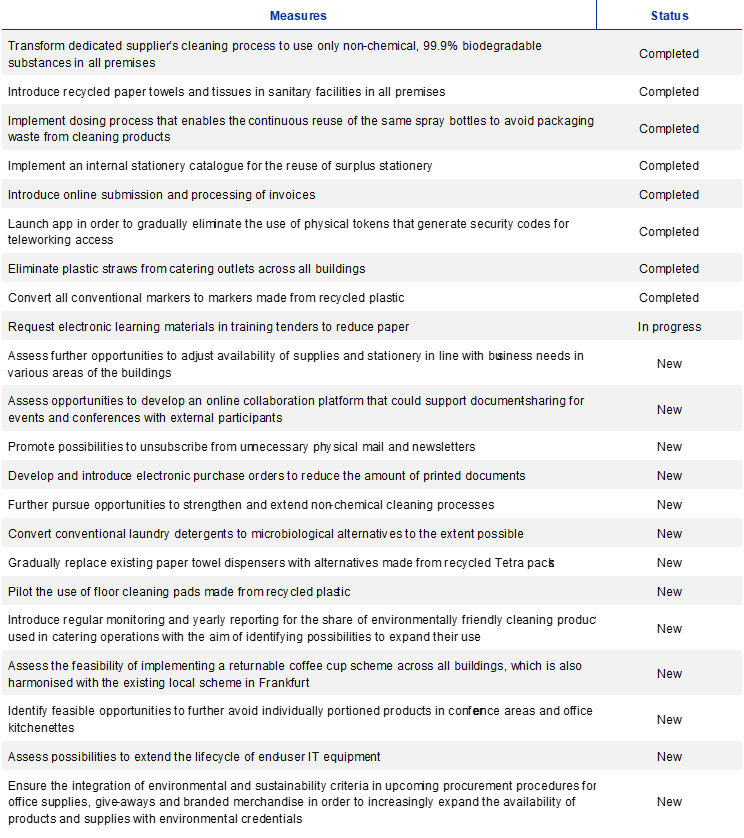
Completed = measure was completed; in progress = measure is in progress; proposal/new = new measure to be implemented in the next programme.

Publications

The amount of paper used for ECB publications has been fluctuating – there has been a general decrease since 2013, with a spike in 2017 related to information campaigns on the new euro banknotes launched in 2016 and 2017. The fluctuating consumption of paper for publication materials is due to the irregular nature of external communication campaigns, which account for most of the paper consumption. As of 2018, the ECB’s paper consumption for publications had fallen to 2.38 tonnes – its lowest point since the reporting process began. It is important to note that, in addition to the absence of specific campaigns that required a certain amount of printing, the digitalisation of communication has strongly contributed to this result. With the launch of the new €100 and €200 banknotes in 2019, we expect to see an increase in paper consumption for external communication purposes.
Chart 3
Paper consumption for official publications
(tonnes)
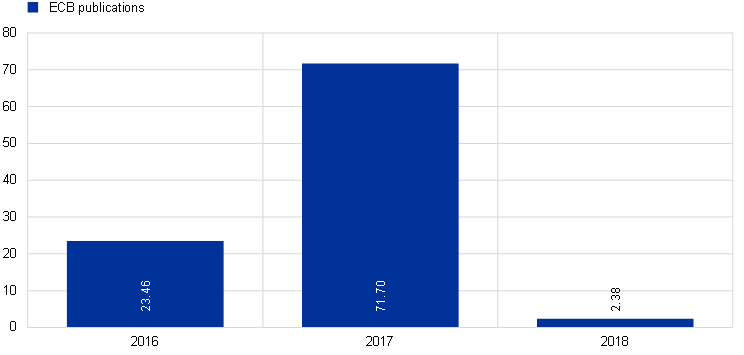
Source: ECB.
Office paper

In 2018 there was also positive news concerning office paper consumption. The ECB’s internal paper consumption decreased by 35.3% compared with the previous year, reflecting a wider process of digitalisation adopted by many different business areas, the further centralisation of printers and the availability of free Wi-Fi for guests and employees in all premises.

Paper consumption per workplace declined by almost 40% compared with 2017, and the share of recycled paper amounted to approximately 90% in 2018. Non-recycled paper is still used for printing high-quality materials, which has been internalised. Generally, the steady reduction shows higher awareness of the importance of reducing printing and an increasingly strong focus on digitalising processes to avoid printing documents where possible. One such initiative was the launch of a new electronic paperless system for submitting and processing vendor invoices, whereby invoices are automatically uploaded into the system and processed via optical character recognition. Moreover, by rolling out e-tendering for larger procurement procedures, paper consumption on both the ECB and supplier sides is substantially reduced, as the submission of all documentation and communication is carried out via the online platform.

See Section 4.7 Green public procurement for additional information.
Chart 4
Office paper consumption
(thousands of sheets (A4 equivalent))
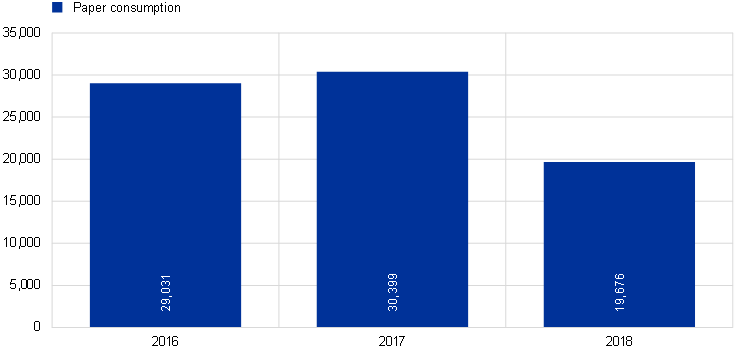
Source: ECB.

Another aspect of material efficiency that should be highlighted is the continued replacement of paper cups within the ECB’s premises, together with the programme to donate decommissioned IT equipment (i.e. laptops and related accessories) to a number of different charities. Moreover, in 2018 coffee capsules from the kitchenettes and platforms of the main building were eliminated as part of the ECB’s commitment to reduce its use of single-use items within its premises.
Cleaning agents

As of July 2018, the ECB has committed to non-chemical cleaning by switching to microbiological cleaning agents across all premises and by using mechanical cleaning methods that only require water wherever possible. Traditional chemical or even hazardous detergents are no longer used.
The microbiological detergents used are 99.9% biodegradable and the dosing process allows the ECB to continuously reuse the same spray bottles to avoid packaging waste. A floor cleaning machine with a self-cleaning water tank means water can partially be reused for floor cleaning. From 2017 to 2018, the use of cleaning agents in the main building decreased by 10.9% thanks to the effort made by ECB internal cleaning services to drastically reduce the use of chemical agents.
In the city centre premises the amount of cleaning agents increased by 21.8%, as in 2018 the ECB started renting the additional floors of the Japan Center building, which required extensive cleaning works following their refitting. An increase in the number of restaurant visitors in the Eurotower also led to an increase in the amount of cleaning agents used.

The introduction of daytime cleaning for the office areas in 2018 had a series of positive sustainability outcomes. It contributed to social fairness by improving the working conditions for the cleaning staff, who not only benefit from full-time contracts but also now work mainly during the business hours of the ECB. The new measure has also been accompanied by a series of environmental measures, such as improving detergent dosing techniques, reducing water consumption and chemical waste, and introducing recycled paper in the sanitary facilities. By servicing the office spaces during day time, it is no longer necessary to turn on lights to carry out the cleaning works. Moreover, better light allows the cleaning staff to better assess the extent of cleaning required, thus saving a significant amount of cleaning materials.
Chart 5
Cleaning agents consumption
(tonnes)

Source: ECB.
Office supplies

In 2018 the share of eco-friendly office supplies in the ECB catalogue remained stable, having reached 37% in 2017. Such products can be easily identified and filtered on the basis of their environmental labels and credentials, highlighted in their description in the supplies catalogue. They can also be easily searched for and identified thanks to the keyword “eco” in their description.
In addition, the internal catalogue for reused stationery is becoming widely used within the bank and has also contributed to a decrease in new external orders. Stationery continues to be handed back to the store room and is thus made available for re-ordering from the internal catalogue. Communication material on how to decrease the environmental impact of ordering stationery and office supplies has also been made available internally.
Chemicals for water treatment and cooling agents

Chemicals used for water treatment and losses of cooling agents are significant environmental aspects that the ECB continuously monitors. In 2018 a total of 9.9 tonnes of chemical substances, mainly composed of salt, were used to soften the water in the technical installations in the main building – a 13.5% reduction compared with 2017.
The 13.2% reduction observed in the city centre premises aligns with the efforts of the ECB’s technical facility management teams to reduce the use of chemicals for water treatment.
In 2018, due to the technical requirements of the cooling equipment and maintenance work being performed, 2.5 kg of cooling agents were used to refill the cooling systems in the city centre. This figure is higher than in 2017 due to exceptional management works.
Chart 6
Chemicals used for water treatment
(tonnes)

Source: ECB.
Chart 7
Cooling agent losses*
(kilograms)

Source: ECB.
Note: *As of 2018 the figures only report losses of cooling agents and not exchanges of cooling agents, as was the case in the previous years. This means that no losses were registered in 2016 and 2017 for the main building.
4.3 Water and waste water

The graphs below show the data related to technical and non-technical fresh water used within the ECB’s premises. Non-technical water includes the water for sanitary facilities, kitchenettes and the canteen. Water consumption across the ECB’s premises can vary greatly due to the structural and building differences, number of workplaces and landscape.

Fresh water consumption at the main building declined by 7.8% compared with the year before. This decline is likely related to the implementation of a more efficient irrigation schedule. Non-technical water consumption declined by 11.4%, whereas evaporation generated by the cooling towers, corresponding to technical water use, increased by 37.9%. The strong increase is directly related to the long, hot summer in 2018 in Frankfurt, which increased the cooling requirements of the building.

In the city centre, fresh water consumption increased in both buildings; specifically, the consumption of non-technical water increased by 7% and technical water consumption increased by 15%. Owing to the increase in workplaces in the Japan Center, water consumption per workplace declined by 2% compared with the year before.

When comparing the water consumption figures for the different buildings, it must be remembered that the wide green areas in the grounds of the main building, and their related irrigation needs, lead to higher water consumption in the main building compared with the city centre.
Chart 8
Water consumption
(m³)
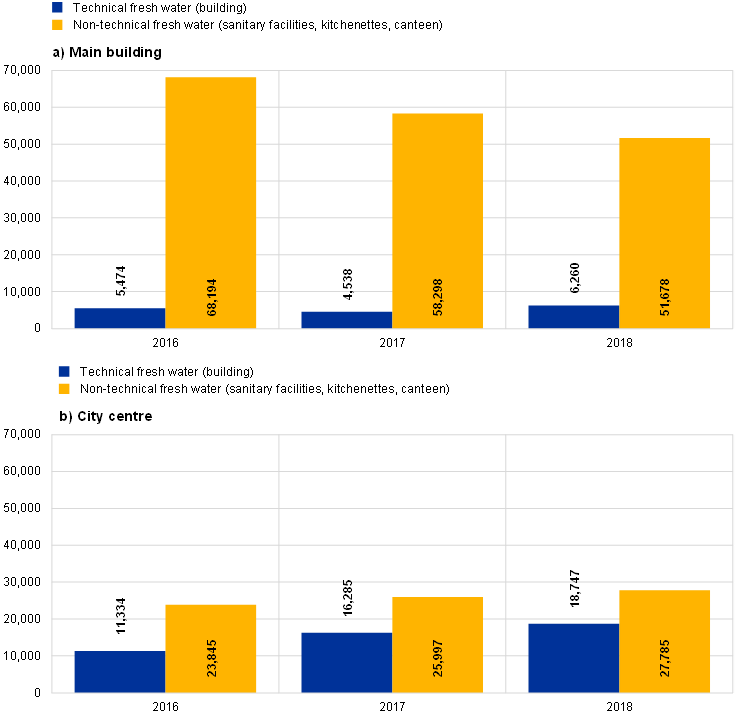
Source: ECB.
Figure 6
Water consumption indicators

Source: ECB.
4.4 Waste and recycling



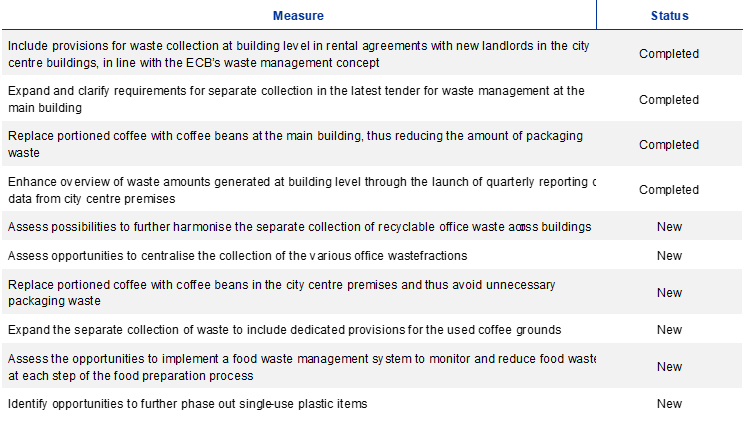
Completed = measure completed; in progress = measure in progress; proposal/new = new measure to be implemented in the next programme.

Compared with 2017, the total amount of waste increased in 2018 by 4.7%, which can be partly explained by the growing number of workplaces. 98% of the ECB’s waste was categorised as non-hazardous. The remaining 2% consisted of 2.9 tonnes of hazardous waste, mainly batteries and fluorescent tubes, and 12.2 tonnes of electronic waste. As a significant portion of current end-user electronic equipment is reaching the end of its lifecycle, it is expected that an increase in such waste will be observed in the following years. Looking at non-hazardous waste, the amount of confidential paper waste has increased by 17.1% in the main building and 22.2% in the city centre. This is directly related to the high number of internal relocations that took place during 2018, which were accompanied by active communication encouraging the prior disposal of unnecessary physical documentation. Another major element of non-hazardous waste is organic waste, which also includes grease separator waste, directly related to the daily preparation of fresh meals in the canteen.
Individual waste fractions in the main building and the city centre showed different developments as described below.

The amount of total waste produced in the main building increased by 9% compared with 2017. Waste reduction and separation remains an important topic for the ECB, which continues to raise awareness among staff and service providers. The reduction of packaging waste and mixed waste may be partly due to the replacement of individually portioned coffee with coffee beans in 2018. This measure has reduced the amount of packaging waste generated, but in the absence of provisions for the separate collection and revaluation of the resulting coffee grounds, the respective fraction has been collected as residual waste. A new tender procedure for a waste management contractor in 2019 is expected to include such provisions.

In the city centre the total amount of waste decreased by 1.7%. Paper and cardboard waste decreased by almost 31%, while confidential paper waste increased by around 19%. The increase in residual waste and the decrease in packaging waste generated in the city centre are directly related to the improved quality of environmental data reporting since 2018. The two charts shown below present significant waste fractions and their development at the ECB.
Chart 9
Waste and recycling
(tonnes)

Source: ECB.
Figure 7
Waste performance indicators

Source: ECB.
4.5 Biodiversity




Completed = measure completed; in progress = measure in progress; proposal/new = new measure to be implemented in the next programme.

The total area of the main building comprises approximately 11.9 hectares of surface area, of which around 4.6 hectares (39%) are sealed and 7.3 hectares (61%) are unsealed. Large green areas and water-permeable pathways allow rainwater to infiltrate the ground, minimising the amount of rainwater discharged into the sewerage system. 6.5 hectares are covered with lawn, meadows and wild flowers.
The vegetation on site enhances the image of a river landscape with a combination of typical river plant life and exotic plants. Most of the trees are deciduous, adapting to the different seasons. Meadows with widely spaced trees are interspersed with dense woods, natural hedges, typical riverbank formations and rows of trees that reiterate the form of river valleys.
Turning to the hardscape, certain areas are paved with cobblestones, which gradually fade into the asphalt or grass areas instead of forming sharp edges. Some of the stones date back to when the Grossmarkthalle still housed Frankfurt’s wholesale market. In addition, some of the contoured river valleys are filled with the kinds of stones typically found in such areas.
Read more about the landscape architecture at the main building.
Rainwater is collected from the roof of the Grossmarkthalle in a storage tank and is used to irrigate the green areas and for some lavatories. Thus, the area that effectively discharges rainwater into the sewage system is reduced to approximately 30 hectares (26% of the total area). The rented ECB premises in the city centre cover approximately 0.7 hectares, of which 0.5 hectares are considered sealed area and 0.2 hectares are considered green area. Since the city centre of Frankfurt is densely built up, there is no opportunity to create infiltration areas around the rented buildings located there.
The ECB’s efforts to further integrate biodiversity as one of its environmental aspects also continued in 2018. Specifically to raise awareness on the importance of biodiversity, the Green ECB team organised an awareness-raising activity with a focus on biodiversity during an open event, where representatives from the local nature conservation group Naturschutzjugend Frankfurt (NAJU) were invited. The experts organised different educational activities for both children and adults. In addition, they provided information on local nature conservation initiatives and possibilities in the area of Frankfurt and showcased ways to directly engage in these activities.
The bird and bat houses and insect hotels installed in 2017 with the aim of fostering biodiversity at the main building continue to be maintained on a regular basis. Their installation has been accompanied by internal communication to raise staff awareness about biodiversity protection. Moreover, approximately 750 trees and various wild flowers and daffodils have been planted in the green areas around the main building.
4.6 Banknotes

The ECB has the exclusive right to authorise the issuance of banknotes within the euro area. At the end of 2018 there were 22.6 billion euro banknotes in circulation.
Since 2002 euro banknotes have been produced jointly by the NCBs of the euro area. Each NCB is responsible for a proportion of the total annual production in one or more denominations.
The ECB seeks to promote good environmental management and minimise the risks to the health and safety of the general public and the workers involved in the production of euro banknotes. When a manufacturer applies to produce euro banknotes, it must provide the ECB with copies of the ISO 9001, ISO 14001 and OHSAS 1800/ISO 45001 certificates issued by the competent certification authorities. These certificates confirm that the manufacturer’s systems conform to the applicable standards at the relevant manufacturing site where the production of euro banknotes is planned to take place.
The ECB’s Directorate Banknotes is taking measures to minimise the environmental impact of the production of euro banknotes. The Directorate monitors manufacturers’ compliance with the ISO 14001 standard and the impact of the production processes of the euro banknotes and their main raw materials. Furthermore, the Directorate also counts promoting initiatives to reduce the environmental impact of producing euro banknotes and being alert to new environmental concerns raised by the public among its key functions.
Cotton combers – a by-product from the yarn industry – are the main raw material used to produce banknote paper. In 2018 approximately 5,990 tonnes of cotton combers were used in this process, 15% of which were certified as originating from a sustainable source in environmental and social terms. The ECB is strongly committed to maintaining and improving the sustainability of euro banknotes by gradually increasing the amount of sustainable cotton in euro banknote paper.
Detailed information on the environmental impact of euro banknotes is provided on the ECB’s website (under “The €uro” section).
4.7 Green public procurement



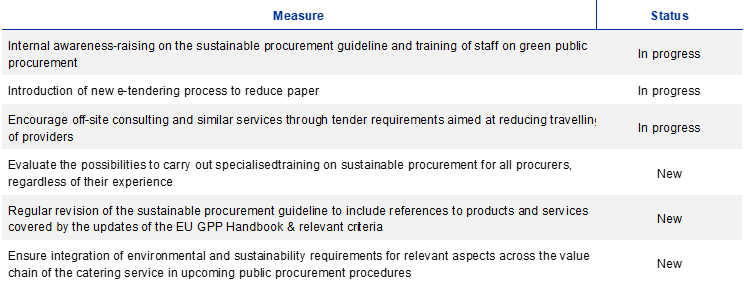
Completed = measure completed; proposal/new = new measure to be implemented in the next programme.

The environmental objective for 2018 was to increase the number of procurements that consider the environmental impact by 25% compared with 2013. This objective was exceeded in 2018 as a total of 46 procurements with environmental considerations were completed, compared with 19 in 2013, resulting in an increase of 142%.
To reduce the amount of paper used by vendors and postal/courier submissions, the ECB introduced electronic tendering procedures for public tenders, requesting the electronic submission of offers and specific documents.
Environmentally relevant criteria are also increasingly included in tenders for service providers. For example, sustainability criteria were taken into account in the tender for a new catering service provider in the main building, which included the offer of organic ingredients and vegetarian and vegan meal options.
In other service tenders such as training courses and seminars, training material was requested in electronic rather than paper form. Moreover, off-site consultation by external service providers was encouraged to reduce the environmental impact of consultants commuting to the ECB.
Furthermore, training sessions on green procurement were organised in 2018. A total of 182 participants across the ECB attended training courses related to green procurement.
The ECB procurement team regularly shares experiences and green procurement approaches in networks and various fora consisting of procurement professionals e.g. at NCBs to promote green procurement business practices.
4.8 Travel activities

Direct exchange of information and collaboration with the NCBs, national competent authorities and other third parties are key components of the ECB’s core business. Participation in international meetings and conferences requires a certain amount of business travel which contributes to the ECB’s environmental impact in the form of fuel consumption and CO2 emissions. Contrary to the increasing trend over the past years and despite growing numbers of workplaces at the ECB, the distance travelled by plane in 2018 slightly decreased compared with 2017 and 2016.

To further encourage and enable staff to reduce business travel whenever feasible, a new videoconferencing and online collaboration tool was launched at the beginning of 2018. It allows collaboration with external as well as internal counterparts. Communication and awareness-raising via internal channels and during the European Mobility Week took place to sensitise staff to the environmental impact of business travel and to inform them about available alternatives.
For internal communication, small-scale videoconference solutions, instant messaging tools and secure teleconferences have been available since early 2015. To facilitate the use of new communication technologies, IT teams offer tutorial sessions to interested teams. Furthermore, the ECB’s travel policy advises staff to only book flights when other modes of transport would take more than four hours and to travel economy class. Emissions caused by consultants commuting have also been considered and addressed by including respective criteria in tenders to encourage off-site consultation.

The use of the ECB car fleet is restricted to the members of the Executive Board, the Chair of the Supervisory Board and the Chief Services Officer and is complemented by pool cars for certain events and circumstances. Opportunities to introduce environmentally friendly alternatives in the existing car fleet are continuously assessed in line with market developments.
5 CO2 emission reduction


*This represents the status of the CO2 objective based on the reporting scope of the past years i.e. baseline 2015, including CO2 emissions from conference participants and excluding compensated CO2 emissions from natural gas. Due to changes in the ECB’s organisational context and reassessment of environmental aspects and impact, it has been decided to adjust the reference year for objectives and measures to 2018. The adaptation is explained in the text below.
**Changing the reference year to 2018 requires the emissions reduction objective to be adjusted in order to maintain the same level of commitment as when the objective was first adopted in 2015. This results in a total emissions reduction objective of 11.3%.
***New baseline (including emissions from natural gas and excluding travel of conference participants).


Completed = measure completed; in progress = measure in progress; proposal/new = new measure to be implemented in the next programme.

The ECB’s CO2 emissions are calculated on the basis of the environmental inventory figures, which are collected and compiled on a yearly basis. Emissions are divided into Scopes 1, 2 and 3 in accordance with the Greenhouse Gas Protocol[6].

In 2018 numerous CO2 emission conversion factors were updated. Following a comparison with the 2017 figures on their respective sources, a table has been created in order to highlight these changes. For further details please refer to chapter 7 - Technical information.
The following graph provides an overview of the emission trends related to the ECB’s activity.
Chart 10
Total CO2 emissions: Scopes 1, 2 and 3
(tonnes)

Source: ECB.

The total CO2 emissions generated by the ECB in 2018 remained relatively stable compared with 2017. Given the developments of emissions and the overall stabilisation in the generic context and activities of the ECB, it was decided to change the reference year from 2015 to 2018 for the objective of reducing emissions by 10% by 2030. However, the total emissions reduction commitment of 1,227.5 tonnes of CO2equivalent, which was made in 2015, is upheld for the new baseline, leading to the objective being changed from 10% to 11.3%. The updated reduction objective therefore relates to the value of 10,878.6 tonnes of CO2 registered in 2018. As detailed in Section 1.1 Relevant changes for the EMS, 2018 is a more representative year for the ECB’s context and activities than 2015.

An increase has been recorded in emissions related to staff commuting to and from work. This development is likely related to the increase in workplaces recorded in 2018. When considering CO2 emissions per workplace, a decrease by approximately 9% can be observed compared with 2017. The Green ECB team is actively working together with key stakeholders to gain insights into the causes of these developments in order to find effective ways of reducing travel-related emissions. For example, in 2018 a new travel booking platform was launched which now incorporates a CO2 companion on the traveller dashboard, showing users the environmental impact associated with their travel. The dashboard is designed to show corresponding CO2 emissions and equivalent “translations” in relatable terms so that staff members can better understand the extent of the environmental impact of their travel. The technical setup of the dashboard is currently being fine-tuned and it is expected to provide additional insights into travel at business area level, which can be used in the future to develop local awareness-raising activities in collaboration with the Environmental Representatives.

Within Scope 1 and 2 emissions, district heating and natural gas account for the largest share, making up around 48% of the ECB’s total CO2 emissions. As the ECB has been purchasing 100% renewable electricity since 2016, emissions from electricity consumption equal zero.

As reported in the previous environmental statements reflecting the practice in place in 2016 and 2017, the ECB’s landlord continued to compensate the CO2 emissions resulting from natural gas in 2018. These are shown in the graphic below.
Chart 11
CO2 emissions: Scopes 1 and 2
(tonnes)

Source: ECB.

The ECB has entered into interinstitutional collaboration with the European Parliament to jointly offset residual CO2 emissions. A joint public tender procedure covering unavoidable CO2 emissions in 2018 has been launched with a view to be finalised by the end of 2019. Nevertheless, continuing to avoid and reduce CO2 emissions remains the strategic priority of the ECB’s EMS.

Scope 3 emissions primarily result from travel activities such as business travel and staff commuting to and from work. The estimated CO2 emissions resulting from staff commute are largely based on assumptions regarding the means of transport used. Therefore, the developments regarding these emissions should be interpreted with caution. In terms of emissions caused by business travel, a change of the business travel service provider in 2018 meant that the underlying database used for the respective emissions calculations is now different, too. This has improved the data quality related to train trips within Germany. However, the 2018 data related to total train travel, including train travel outside Germany, were incomplete. Therefore, train rides recorded in 2017 were used for 2018 CO2 emissions calculation and adjusted in line with the increased rate of workplaces of 7.4%. The biggest share of CO2 emissions resulting from business travel is generated by plane trips. However, in 2018, a positive development was observed as the distance travelled by plane in 2018 was lower than both in 2017 and 2016. This development may partly be attributed to the launch of a new online collaboration tool, which can also be used by external counterparts for the first time.
Efforts to enhance data quality and granularity in relation to travel activities will continue in the coming years, with the aim of improving reporting and gaining insights into further opportunities to achieve emission reductions.
On the basis of the past developments, it was decided to no longer estimate and report the emissions resulting from travel of third parties to the ECB to attend high-level conferences, events or seminars.
This decision was taken because sample checks revealed a high probability of double-counting the respective emissions as business travel by the delegates, calculating the emissions requires a substantial amount of estimation, and it is difficult to influence whether and how delegates choose to travel to the ECB. However, we will continue to pursue measures aimed at reducing the environmental impacts associated with this aspect.
Chart 12
CO2 emissions: Scope 3
(tonnes)
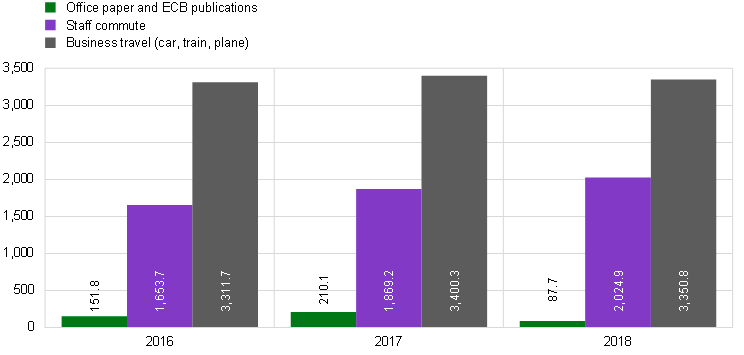
Source: ECB.
Chart 13
Shares of CO2 emissions
(tonnes)
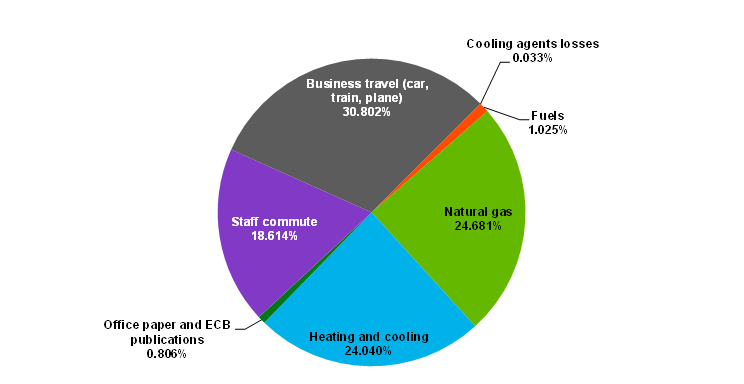
Source: ECB.
Finally, CO2 emissions related to office paper and paper used for publications have dropped drastically in line with the decreased amount of consumed paper (see chapter 4.2 - Material efficiency). Since 2013, the energy used for the external data centre has been accounted for entirely by renewable energy and, as a result, the corresponding emissions have been avoided.
In addition to the previously illustrated emissions, the amounts of emitted sulphur dioxide (SO2), nitrogen oxides (NOx) and particulate matter (PM) are also monitored and reported. These specific emissions arise directly from the use of ECB-owned cars, test runs of emergency power units and consumption of natural gas. For the specific figures related to these emissions please refer to chapter 7 – Technical information.
6 Conclusions
Overall, the Environmental Management System at the European Central Bank continued to perform well in 2018. The ongoing improvement in both its environmental performance and the communication around it is visible in the results reported above. The trends linked to the identified significant environmental aspects have shown a general improvement, with some aspects performing better than others. Despite this divergence in performance of significant aspects over the past few years, the ECB environmental footprint has been shrinking, meaning that less and/or better-sourced energy has been consumed, and fewer resources have been used to ensure the functioning of the sites.
By means of a systematic approach to environmental management, the ECB has successfully managed to gradually reduce its carbon footprint over the past few years. In addition, with a new cycle of the Environmental Management Programme about to commence, previously set environmental objectives have been reviewed, new objectives have been outlined and corresponding measures have been identified in line with the ECB’s commitment to continual environmental improvement.
Internal engagement appears to be the key factor in achieving the objectives and related measures. It is essential for all levels of staff and the ECB as a whole to maintain their environmental commitment and active engagement, including the mainstreaming of environmental considerations into all administrative activities at the ECB.
The challenge will therefore be to maintain a continuous improvement, as conceived by the EMAS framework, also in consideration of the changes in workplaces and building performance. The Green ECB and all the Environmental Representatives will need to step up their efforts even further, with the strong and sustained support of senior management. The ECB will also need to closely cooperate with contractors responsible for catering and cleaning services, building refurbishment and IT systems.
7 Technical information
The previous chapters report and explain the developments and activities of the ECB’s most relevant environmental aspects. In line with the requirements of the EMAS regulation, this next chapter aims to summarise further details and provide additional insights regarding the ECB’s environmental performance.
The following table shows the variation of the CO2 emission conversion factors used to calculate the emissions reported in the previous chapters. The difference between the years 2017 and 2018 is based on the latest figures provided by the corresponding sources[7].
Conversion factor update
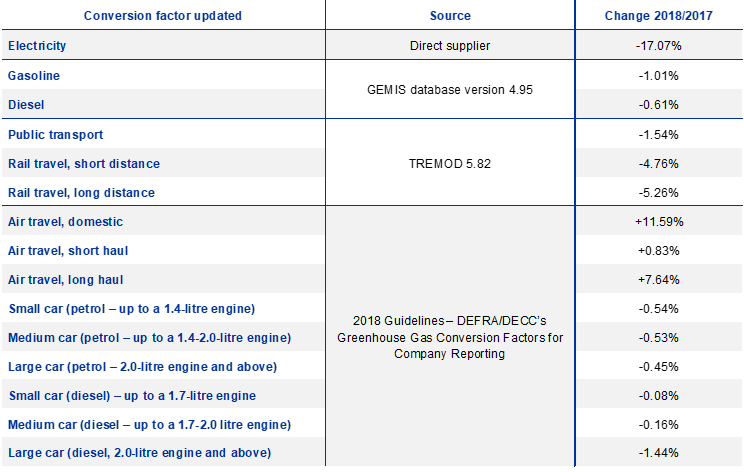
Environmental performance indicators (workplace indicators) 2016-2018
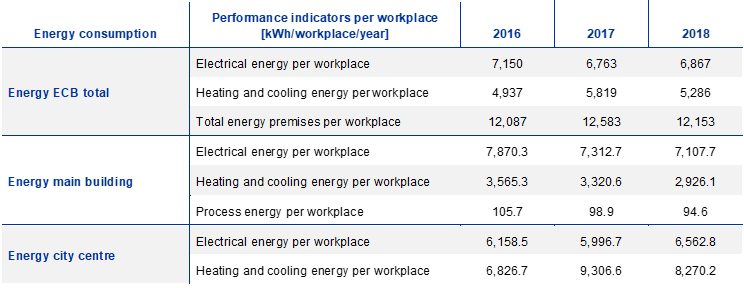


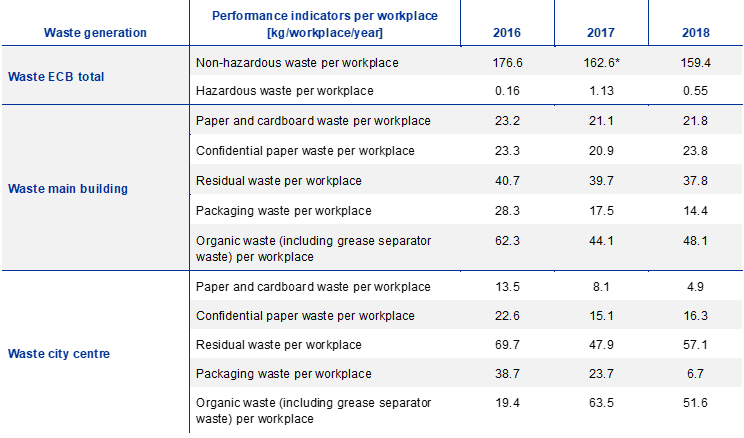
*The total amount of non-hazardous waste in 2017 has been adjusted following an improvement in the monitoring and reporting process. Therefore, the amount of non-hazardous waste per workplace changed from 202.9 to 162.6 kilograms in 2017.




*Following a readjustment in measurements, the figures related to the total land use and consequently the respective ratio of sealed and unsealed area have been modified compared with what was previously reported.
7.1 Environmental Management Programme

8 Environmental verifier’s declaration
Environmental verifier's declaration on verification and validation activities
The undersigned, BSI Group Deutschland GmbH, an environmental verification body with the registration number DE-V-0228, accredited and licensed for the areas of “Financial service activities, except insurance and pension funding” (NACE Rev, 2: NACE 64), confirms that it has verified whether the environmental declaration of the European Central Bank (ECB), at its sites at Sonnemannstrasse 20, 60314 Frankfurt am Main, Germany (main building) and at Kaiserstrasse 29, 60311 Frankfurt am Main, Germany and Taunustor 2, 60311 Frankfurt am Main, Germany (city centre), with registration number D-125-00045, meets all the requirements of Regulation (EC) No 1221/2009 of 25 November 2009 as amended by Commission Regulation (EU) 2017/1505 of the European Parliament and of the Council of 28 August 2017, on the voluntary participation by organisations in a Community eco-management and audit scheme (EMAS).
The signature of this validation confirms that:
- the verification and validation has been carried out in full compliance with the requirements of Regulation (EC) No 1221/2009 as amended by Commission Regulation (EU) 2017/1505;
- the result of the verification and validation confirms that there is no evidence of non-compliance with applicable environmental legislation;
- the data and information in the environmental statement give a reliable, credible and truthful picture of all the organisation’s activities within the scope specified in the environmental statement.
This document is not equivalent to EMAS registration. EMAS registration can only be granted by a competent body under Regulation (EC) No 1221/2009.
This document shall not be used as a standalone piece of public communication.
Frankfurt am Main, 25 June 2019
Dr Rainer Feld
BSI Group Deutschland GmbH Umweltgutachterorganisation
Environmental verification body
(DE – V – 0228)

Disclaimer
This environmental statement provides information to the general public and other interested parties about the environmental performance and activities of the European Central Bank (ECB) in 2018. It can be found on the ECB’s website (see the page entitled “Environmental protection at the ECB”).The ECB was first validated under the EU Eco-Management and Audit Scheme (EMAS) in 2010. This environmental statement, which is the tenth to be produced within the EMAS validation cycle, reflects the fourth consolidated environmental statement after 2010, 2013 and 2016.This environmental statement was drafted in accordance with EMAS standards according to Regulation (EC) No. 1221/2009 and the updated annexes of the EMAS Regulation according to Regulation (EC) 2017/1505.
© European Central Bank, 2022
Postal address 60640 Frankfurt am Main, Germany
Telephone +49 69 1344 0
Website www.ecb.europa.eu
All rights reserved. Reproduction for educational and non-commercial purposes is permitted provided that the source is acknowledged.
For specific terminology please refer to the ECB glossary.
Out of scope sites: ECB representative offices in Brussels and Washington D.C.
Annexes I, II, III of Regulation (EC) No 1221/2009 were amended in 2017 to include changes associated with the revision of ISO 14001:2015. Commission Regulation (EU) 2017/1505 entered into force in September 2017. According to Commission Regulation (EU) 2018/2026, an amendment of Annex IV has also been in force since January 2019.
Speech of Benoît Coeuré at a conference on “Scaling up Green Finance: The Role of Central Banks” Berlin, 8 November 2018; Panel remarks by Sabine Lautenschläger at the Network for Greening the Financial System Conference, Paris, 17 April 2019.
The concept of “workplaces” is used in the ECB’s EMS to depict the number of people working on ECB premises, regardless of contractual status or arrangements, therefore also including non-ECB staff such as consultants, contractors, etc. EMAS, on the other hand, uses number of employees or full-time equivalents.
The increase refers to the Japan Center building only.
The Greenhouse Gas Protocol is the most widely used international accounting tool for government and businesses wanting to understand, quantify and manage greenhouse gas emissions.
Conversion factors are provided by: the UK government’s Department for Environment, Food and Rural Affairs (DEFRA) and the Department of Energy and Climate Change (DECC); the German Ministry of Environment (Umweltbundesamt); the ECB’s energy supplier, Mainova; Deutsche Bahn; the Global Emissions Model for Integrated Systems (GEMIS); and the Institute for Energy and Environmental Research (IFEU Institute).
- 7 October 2020
- 26 July 2021



